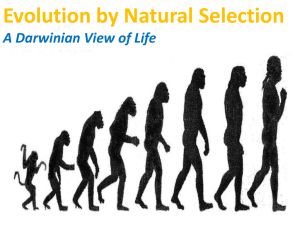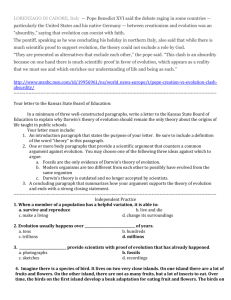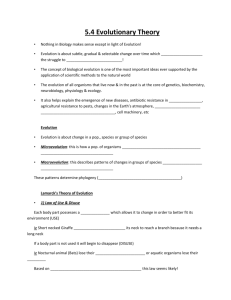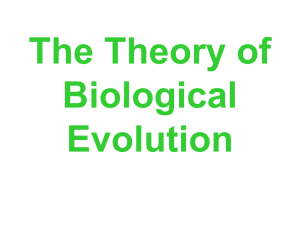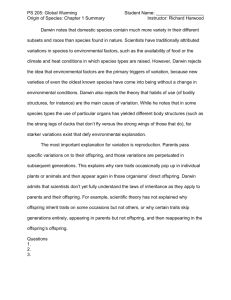Quiz - byrdistheword
advertisement
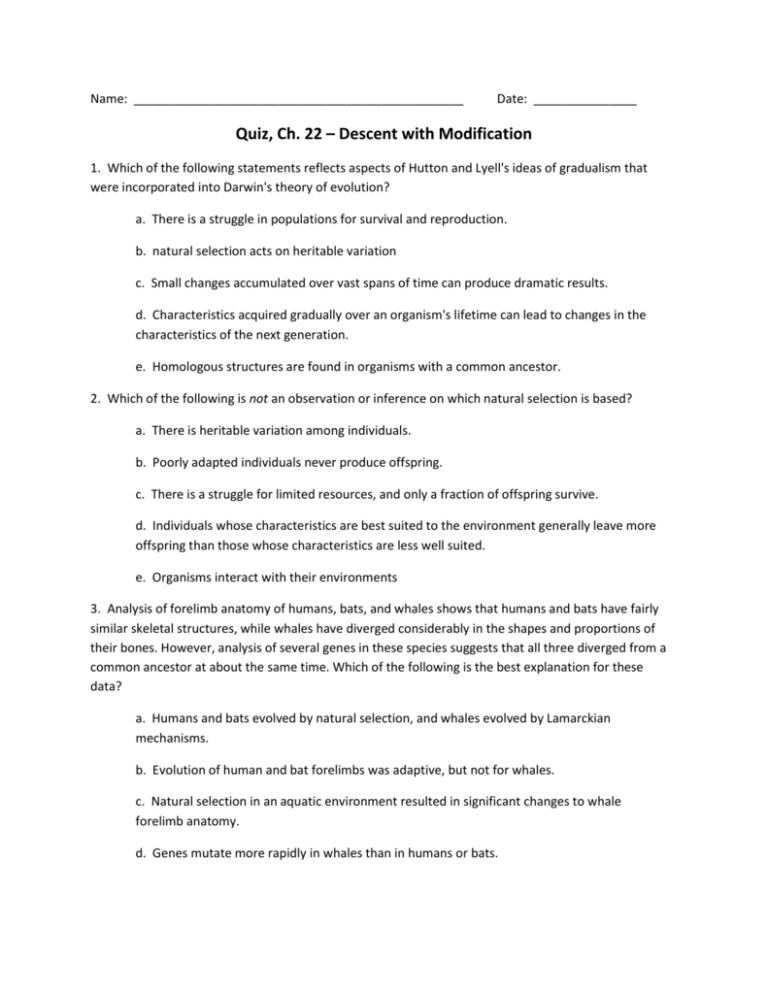
Name: ________________________________________________ Date: _______________ Quiz, Ch. 22 – Descent with Modification 1. Which of the following statements reflects aspects of Hutton and Lyell's ideas of gradualism that were incorporated into Darwin's theory of evolution? a. There is a struggle in populations for survival and reproduction. b. natural selection acts on heritable variation c. Small changes accumulated over vast spans of time can produce dramatic results. d. Characteristics acquired gradually over an organism's lifetime can lead to changes in the characteristics of the next generation. e. Homologous structures are found in organisms with a common ancestor. 2. Which of the following is not an observation or inference on which natural selection is based? a. There is heritable variation among individuals. b. Poorly adapted individuals never produce offspring. c. There is a struggle for limited resources, and only a fraction of offspring survive. d. Individuals whose characteristics are best suited to the environment generally leave more offspring than those whose characteristics are less well suited. e. Organisms interact with their environments 3. Analysis of forelimb anatomy of humans, bats, and whales shows that humans and bats have fairly similar skeletal structures, while whales have diverged considerably in the shapes and proportions of their bones. However, analysis of several genes in these species suggests that all three diverged from a common ancestor at about the same time. Which of the following is the best explanation for these data? a. Humans and bats evolved by natural selection, and whales evolved by Lamarckian mechanisms. b. Evolution of human and bat forelimbs was adaptive, but not for whales. c. Natural selection in an aquatic environment resulted in significant changes to whale forelimb anatomy. d. Genes mutate more rapidly in whales than in humans or bats. 4. Darwin synthesized information from several sources in developing his theory of evolution by natural selection. Which of the following did not influence his thinking? a. Linnaeus' hierarchical classification of species b. Lyell's Principles of Geology c. observations of molecular homologies d. examples of major changes in domesticated species produced by artificial selection e. the distribution of species that he observed on the Galápagos Islands and during his journey around South America 5. Within a few weeks of treatment with the drug 3TC, a patient's HIV population consists entirely of 3TC-resistant viruses. How can this result best be explained? a. HIV has the ability to change its surface proteins and resist vaccines. b. The patient must have become reinfected with 3TC-resistant viruses. c. HIV began making drug-resistant versions of reverse transcriptase in response to the drug d. A few drug-resistant viruses were present at the start of treatment, and natural selection increased their frequency. e. The drug caused the HIV RNA to change 6. The major weakness of Darwin's theory (as it existed in 1859) was that it could not explain _____. a. why species become extinct b. why different parts of the world have different plants and animals c. why vestigial structures exist d. how advantageous traits are passed to offspring e. none of the above 7. The modern idea of extinction as a common occurrence in Earth's history was first proposed in the early 19th century writings of _____. a. Cuvier b. Lamarck c. Aristotle d. Wallace e. Lyell 8. Carolus Linneaus is considered to be the founder of _____ and _____. a. paleontology ... believed in catastrophism b. gradualism…believed the same geographic forces are operating today that occurred in the past c. evolution…first proposed that acquired characteristics are inherited d. taxonomy…thought that resemblances among different species reflected the pattern of their creation 9. Darwin was well aware of what effect his theory of evolution would have on the public and on the Church of England. This was why he delayed publishing his work for several decades while he gathered additional evidence. Which one of the following was not evidence he used to support his theory? a. the common belief about the age of the earth b. many more offspring are produced than can survive c. When breeders select for specific traits, these become fixed in future generations. d. Some individuals leave more descendants than other individuals e. In a population of organisms, every individual is different from every other one 10. Which term or phrase below can be referred to as a summary of Darwin's view of life? a. adaptive evolution d. differential success in reproduction b. natural selection e. inheritance of acquired characteristics c. descent with modification 11. Natural selection primarily favors: a. phenotypes b. genotypes c. mutations d. heterozygotes e. homozygotes 12. Which of the following factors is not an important part of natural selection? a. limited environmental resources b. heritable variation c. selective breeding of domestic plants and animals d. individuals better adapted to an environment being more likely to survive 13. According to the theory of evolution, all of the different kinds of homologies—namely, anatomical, molecular, and embryological—should ___: a. be completely independent of each other b. produce similar patterns of evolutionary relatedness c. yield very different hierarchical patterns d. ink all of the species currently present on Earth 14. A population of zooplankton is exposed to a small number of predatory fish that feed on the largersized (adult) zooplankton. Which of the following predictions would most likely occur based on the principles of natural selection? a. The predatory fish will evolve smaller mouths so that they do not drive their prey to extinction. b. The zooplankton will become sexually mature at larger sizes c. The predatory fish will evolve poor eyesight so as to preserve their food supply. d. Adult zooplankton will start to reach sexual maturity when they are still relatively small. 15. An important challenge to traditional (pre-1860) ideas about species was the observation that seemingly dissimilar organisms such as hummingbirds, humans, and whales have similar skeletal structures. This most directly suggested to biologists that _____. a. only the best-adapted organisms can survive b. advantageous changes can be passed along to offspring c. most evolution occurs rapidly following a mass extinction’ d. dissimilar organisms might have evolved from a distant, common ancestor e. all of the above 16. Vestigial organs are _____ a. evidence for Lamarck's theory of use and disuse b. remnants of structures that were useful to an organism's ancestors c. one piece of evidence that does not support the theory of evolution d. examples of anatomical imperfections such as the human knee e. homologies that can only be observed in embryos




